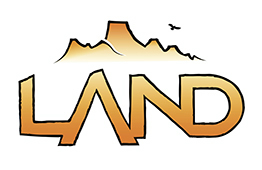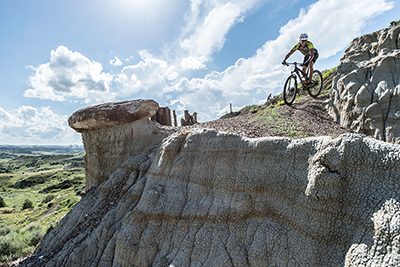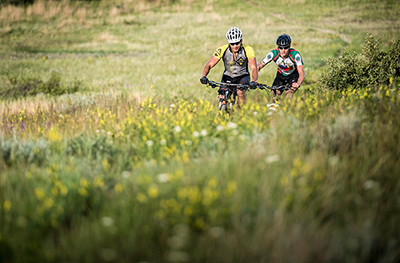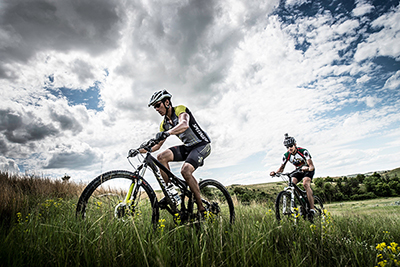For discussion
July 2015
Keeping the Trail: Biking in the Badlands

Along with his wife Lindsey, Nick Ybarra founded Legendary Adventures New Discoveries (L.A.N.D.), located in Watford City, North Dakota. L.A.N.D. exists to create legendary adventures for people to uncover new discoveries. Specifically, creating opportunities for people to experience the Badlands. In this article, Nick discusses how L.A.N.D. works to keep the Maah Daah Hey Trail from disappearing. One of L.A.N.D. efforts includes hosting mountain biking races, Maah Daah Hey Series, in the hopes to bring attention to the trail, to get more people traveling it, which will decrease the needed maintenance. Located in the Little Missouri National Grassland, the Maah Daah Hey Trail is a 140 mile non-motorized single track trail through the Badlands. The trail is recognized as one of the top mountain biking trails in the United States, and has been designated as an IMBA EPIC Ride.
What drew you to the Badlands and the Maah Daah Hey Trail in particular?
My wife, Lindsey, and I grew up in North Dakota (ND). We absolutely love the Maah Daah Hey (MDH) Trail. Located in the Little Missouri National Grassland, the MDH Trail is a 140 mile non-motorized single track trail through the Badlands of ND. When we graduated from college, Lindsey and I moved back to Lindsey’s home town of Watford City. I got a job as a youth pastor at a local church. I always knew that eventually one day I wanted to do something that took teenagers out to the Badlands to camp, canoe, teach, and just enjoy the outdoors, because that was how I was introduced to the MDH Trail. I was invited to go on the Trail with a Bismarck church group. At the time I had a Schwinn mountain bike from Wal-Mart, went out on the MDH Trail, and I absolutely fell in love with it!
Going out to the Badlands and just seeing how amazing the Maah Daah Hey Trail is what really woke something up inside me. It gave me the opportunity to experience a real adventure. I heard the stories about the people riding the whole trail in one day. I made that my goal and I rode the whole trail in one day in June 2009. Then I rode it again and it was then that I realized there needed to be an event so that people could experience the trail. I wanted to start L.A.N.D…. I wanted to take people out into the wilderness, to the Badlands particularly, because that’s my favorite place to be.

Photo by Chad Ziemendorf
What is L.A.N.D.?
Lindsey and I created Legendary Adventures New Discoveries (L.A.N.D) together about five years ago. We love the Badlands and want to share that with others. L.A.N.D. exists to create legendary adventures for people to experience new discoveries. Specifically, creating opportunities for people to experience how amazing the Badlands are. We have a lot of great ideas of what we want L.A.N.D. to eventually be, like canoeing on the Little Missouri River, taking groups out paintballing, and going out for camping trips. However, we decided to start with mountain bike races—the Maah Daah Hey Series.
We felt the mountain bike races was a good opportunity to establish our name and build our reputation, as well as the best opportunity to raise the funds for everything else that we want to do in the future. We started L.A.N.D. with a donation from a friend. We purposely wanted to grow L.A.N.D. slowly so that we could keep up with it. We both work full-time and have two small daughters. We also never anticipated the extra work of trail maintenance when we originally started.
Right now L.A.N.D. is a sole proprietorship owned by Lindsey and me. However, after this year’s race we will become a non-profit so that it is easier for other organizations, who believe in what we’re doing, to make donations. We love the Badlands and we want to see the Maah Daah Hey be the best trail that it can be.
So what is the Maah Daah Hey 100?
The Maah Daah Hey 100 is a point to point race on the Maah Daah Hey Trail between the USFS CCC campground and Medora, ND that is about 100 total miles of trail. Our race started in 2012 with 60 participants and this year (our fourth year) we have over 345 participants so far, and it still has a lot of potential to grow.
The first year we hosted the race for free as a trial. All of our participants helped us to see how it would work, what needed to go into it, and how to make it safe and enjoyable for everyone. We’ve learned a great deal along the way. Being able to organize that many people is a big responsibility given the location and the nature of the Badlands. The Badlands are one of the most remote places in the nation, which is why there is a big draw for people to want to get away and visit them, but it makes emergency rescues very challenging. We put additional markers on the trail on the race day because we don’t want anybody getting lost. Knowing some people will have emergencies out on the trail we have to have a good plan of action for helping people for whatever situations come up.
For instance, some people come out to the races not realizing how difficult of a challenge the Maah Daah Hey Trail really is. Most of the people who come prepared finish the race. But we have some who start and never make it to the finish line, because the race is very very challenging. The trail itself is really rugged, really raw. We get people coming from Colorado or Utah who have such nice, maintained, and popular trails that are frequently traveled and stay in really good shape. However, then you come out to the Badlands and it is a 100 miles of single track trail, that doesn’t get the same amount of maintenance, it is also a shared trail (it gets trampled by cows and horses), and it really is just a rugged trail. It takes more time to travel a rugged trail than it does a nicely maintained, smooth trail.

Photo by Chad Ziemendorf
You’ve mentioned the state of the trail, and trail maintenance. What part does that play in the Maah Daah Hey 100?
When we moved back to Watford City in 2008 the trail was in pretty good shape. The US Forest Service usually had trail crews that they’d hire to do that work. The crews of a dozen people or more would work on the trail all summer. Then suddenly we started getting really rainy seasons in western ND. The trail used to be almost desert type conditions. The location of the trail was easy to find and not a lot of vegetation grew along the sides of it. The past five years or so we’ve had just unusual amounts of precipitation and as a consequence, the vegetation started growing, and there were a lot of landslides and erosion. Unfortunately, the trail started to be lost to those conditions. It got to the point where the only trail that I had to ride was disappearing.
I had no interest and no intention to ever get involved in trail maintenance. I preferred to just ride as much as I could. But at the point that the trail was unrideable we needed to start helping or just watch the trail disappear.
I thought that Maah Daah Hey 100 would probably be the best thing to keep the trail alive. The thought was that by bringing attention to the trail, the more people we bring to it, the more traveled it is, the more it is going to stay maintained. To host the race we’d have to maintain it to meet the standards at a level where people would expect an event to happen.
To start, we contacted the Forest Service and our first question was why isn’t the trail being maintained? For them, they had multiple problems at the same time. They couldn’t get trail crews as they’d used to. Partly due to the oil boom. So for the past four years they’ve had maybe one or two people designated for trail maintenance out there on the trail. Add up all the factors--smaller trail crew, more rain, more vegetation, and the trail becomes less findable, less usable, less enjoyable—and then you have less people traveling it. The trail was just going to go away.
I’d never done trail maintenance in my life, but I got ahold of some good biking buddies in Bismarck who do some maintenance on the mountain bike trails there and we made a plan. We brought mowers, weed whackers, and shovels and we started only fixing what the forest service would allow volunteers to do. They let us mow, weed whack, trim branches, and then anywhere there was a landslide we could move the dirt a little bit to make it so it was a trail again. It just amazes me how the past two summers we, as volunteers, have mowed the trail from end to end. That’s a total of 100 miles of trail, and the trail has to be mowed on each side just to be wide enough so as you are biking along the tall grass on the side isn’t hitting your hands and the handlebars and chapping at your legs as your peddling by. That adds up to 200 miles of mowing. It would be nice if you could mow it one year, and the next just do dirt work and shovel; however, with all the rain we’ve been getting every year, the grass all grows back and needs to be mowed again by June.
Who are the volunteers for trail maintenance?
It has been just a handful of mountain bikers, people who can make the time. We have a lot of guys coming from Bismarck, we’ve got a few from Dickinson. If we do a really long day from sunup to sundown we can do about 10 miles of the trail. For the past two years it has been taking us about three weeks total, about 600 volunteer man hours, to keep the trail usable. Since we do it for the race, as L.A.N.D., it has been a huge expense for us. Just putting gas into the brush mowers, gas into the trucks to get out there, trying to bring food for the day and feed our volunteers, the cost adds up. The whole goal for doing the race was to start raising funds to do the other things we wanted to do. Though the volunteers mow, trim, dig, and maintain each side of the course with no reimbursements or compensations, the unexpected expenses of the trail maintenance have still been high enough that L.A.N.D. has yet to turn a profit.
Also, North Dakota Tourism has a pretty good idea of what we are doing out here. They are promoting the Maah Daah Hey Trail and encouraging people to use it. The Maah Daah Hey 100 received an events match grant through them. We received $5,000 for each of our races, and that helped a lot.

Photo by Chad Ziemendorf
What do you hope for the future?
My wife and I think that the Maah Daah Hey Trail is one of the best trails in the world and we could not simply just watch the trail literally disappear, due to overgrowth, underuse, and lack of maintenance. We want to continue to be able to do the things we love, and know that it helps improve things for everyone else who likes to use that trail whether it be for hiking or horse riding or anything else.
Hopefully it will get to the point where the Forest Service can get back involved with the trail maintenance. Or maybe we can come up with a plan where we raise funds to do the trail maintenance and we take care of the trail. In the meantime, we are definitely open to partnering with people and getting as much help as we can get. The people who have volunteered and donated to what we’re doing are people who have approached us and said, “Hey we see what you’re doing, we believe in it, we want to be a part of it.” Those are the kind of people who we want to help. People who believe in what we are doing and are passionate about it and who want to support us through work or funds.
For any trail there is a certain level of responsibility for the trail users to pitch in and help keep that trail going, but I think it’s a very unique situation how involved the trail users are on the Maah Daah Hey. It’s something that I’ve proven over the past couple of years that I am willing to fight for. It’s really important to us and we know the more help that we can get, the better that the trail can be.
www.experienceLAND.org
http://www.ndtourism.com/medora/attractions/maah-daah-hey-trail
